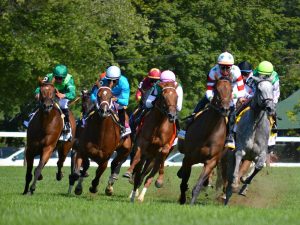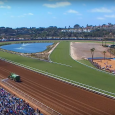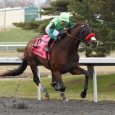By Maryjean Wall

Horse Racing – USR Photo
Spectators at Sportsman’s Hill kept an eye out for angry Native Americans during the races. If you let down your guard you could do worse than losing all on a 2-5 shot. You could wind up scalped.
Sportsman’s Hill was the estate of pioneer William Whitley, who brought the racing traditions of his native Virginia with him when he crossed into Kentucky on horseback in 1775. More important was the tradition he founded: racing counterclockwise around a circular, dirt track.
Stories hold that Whitley was swayed by anti-British sentiment when he decided that horses should race in the opposite direction they ran in England. This made sense, since Whitley was a Revolutionary War veteran, harboring a disdain for anything British.
For the same reason, he decided that racing on his estate would take place on dirt, in opposition to British practices of racing on turf. He built the first circular race track west of the mountains, a track that is open to visitors today.
Racing at Sportsman’s Hill was an annual affair held during autumn, following the harvest. The races began in the mornings and followed a hearty breakfast served on the grounds. Patrons wolfed down a buffet of broiled squirrel, roast duck, leg of bear, and a possum or two. They washed this down with “old bourbon whiskey” or buttermilk, depending on each individual’s inclinations.
Whitley, the man presiding over the racing, was well known as an Indian fighter. He had scalped numbers of Natives after seeing them scalp his fellows along the frontier. Later, during the War of 1812-1814, he would be credited by some as the killer of the famous Chief, Tecumseh. But during the latter 1700s his job was to keep Natives from attacking his home, his family, and the pioneers who patronized his race course. It was a big job, with the Natives acting out their dismay over Virginians and North Carolinians taking their land.
Settlers like Whitley operated in defiance of the notorious Proclamation of 1763, which prohibited settlement west of the Appalachian Mountains. England’s King George III had promised Natives that this land would remain forever theirs but we all know how that went. Settlers began trickling in behind Daniel Boone and other land surveyors so that by the time of the Revolution, all bets favoring the Natives keeping their land were off. Settlers were streaming into Kentucky like there was gold at the end of the journey. The Natives did not sit back, so it was no small irony that they captured Daniel Boone’s daughter, Jemima. Boone and his explorer pals had started the great land heist, after all.
Whitley and his cohorts did not sit back, either. They struck at the Natives by burning their villages, taking Indian captives, and stealing horses and livestock. It was difficult to differentiate the good guys from the bad guys because even in the moment, Whitley grew his reputation as a hero. He rose to the rank of captain in the Kentucky Militia. No one asked how the Natives viewed Whitley but the construction of his brick home (which stands today) gives us a clue that relations with the Natives were not good. Whitley built a wide ditch around the building. Can you say, “moat?”
The house lacked a porch or steps; the only way to get up and into the house was by grabbing a rope. The windows were built high. The house had a secret passage that could be used in case of Indian raids. On the race course or inside their home, the Whitleys rested uneasy.
This was too bad, as Whitley’s wife, Esther, had endured indescribable hardships while following her husband to Kentucky. Whitney wrote that “at times my wife would fall, horse and all,” along the narrow footpaths over the Cumberland Gap. He tied his wife and children together on their individual horses so they could follow one another in a single line along the paths. Sometimes they had to unpack the horses and carry their possessions over the mountains, horses to follow. The crossing took 33 days.
That spring of 1776, when the Natives took Boone’s daughter, was a tough one on the frontier. Little thought was wasted here on the Revolution, even as the Revolution was beginning to find its ground in the East. Those like the Whitleys, living in isolated areas, fled to nearby forts after Boone’s daughter wound up with the Indians. The Whitleys fled first to a fort at Stanford, Ky., but decided that fort was insufficient protection. Instead they went to Fort Harrod (now Harrodsburg, Ky.), where they remained until 1777. The United States had declared its independence from Great Britain a year previously but the Natives and settlers were still duking it out on the frontier.
Whitley was still fighting Natives in 1793, traveling to Nashville, Tennessee, to engage Indians five years after he had built his racetrack in Kentucky. And he was fighting Natives in the War of 1812-1814, fought in North America against Britain, when he reportedly killed Tecumseh at the Battle of the Thames in Ontario. Whitley also died in that battle. He is buried near Chatham, Ontario, far from Kentucky where he brought organized racing to the frontier and established traditions that endure in North American racing some 230 years later.




